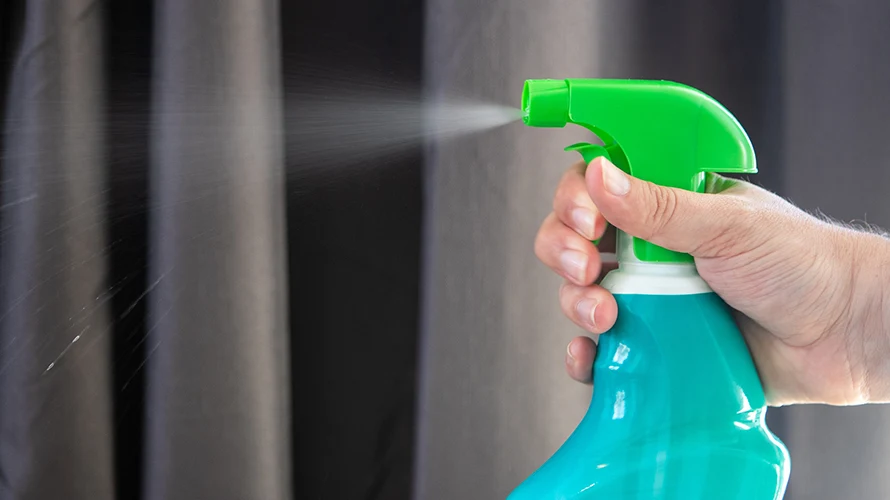A quick overview of the topics covered in this article.
Subscribe to the UKPACK newsletter to receive regular updates on the company, products, services, upcoming exhibitions and more.
Using a spray bottle to discipline a pet has become a common practice among many pet owners. It is a quick and easy way to stop unwanted behavior, such as chewing or jumping, without using physical force or punishment. However, the use of spray bottles on dogs is a controversial topic, with some experts arguing against it.
In this article, we will discuss whether spray bottles are an effective training tool for dogs and present some alternatives for pet owners.
Do Spray Bottles Wotk on Dogs or Cats
Using a spray bottle to train your dog is not an effective method. In fact, dog trainers have observed cases where pet owners would spray their puppies for mouthing or their cats for scratching their furniture, only to be met with little to no success. For instance, one client had two large water bottles in each room to prevent her cats from clawing her furniture. Despite her consistent use of the spray bottle during a consultation, her cloth furniture was left in tatters with shredded cloth strings dangling. This only goes to show that using a spray bottle on your cat or dog does not work.
Why Doesn’t Spraying a Dog with Water Work?
Using punishment as a training method does not effectively teach your dog (or cat) what behavior is expected of them. For example, squirting your dog with a water bottle may temporarily stop them from a certain behavior, such as scratching furniture or barking, but it fails to teach them what behavior is desired instead. In fact, punishment may even reinforce the undesired behavior when the punishing object or person is not present.
To understand this better, consider the example of receiving a speeding ticket. While the punishment is effective in getting you to slow down, it only works temporarily. You may slow down near the area where you received the ticket, but once the police are no longer present, you may resume your previous behavior of speeding through that area. The same can happen with dogs who are punished for their behavior. They may refrain from the behavior while the punishing object or person is present, but they may continue the behavior when the punishment is not present.
To successfully change your pet’s behavior, it’s important that the undesired behavior is eliminated permanently, even when the punishing object or person is not present. Simply using a water bottle to stop the behavior temporarily may not be effective in achieving long-term results.
Additionally, some pets may actually enjoy being sprayed with water, turning the punishment into a game for them. This can lead to a further reinforcement of the undesired behavior, making it even more difficult to eliminate. It’s important to consider alternative training methods that prioritize positive reinforcement and redirecting behavior, rather than using punishment that may cause more harm than good.
Why Doesn’t Spraying a Dog with Water Work?
Using punishment as a training method does not effectively teach your dog (or cat) what behavior is expected of them. For example, squirting your dog with a water bottle may temporarily stop them from a certain behavior, such as scratching furniture or barking, but it fails to teach them what behavior is desired instead. In fact, punishment may even reinforce the undesired behavior when the punishing object or person is not present.
To understand this better, consider the example of receiving a speeding ticket. While the punishment is effective in getting you to slow down, it only works temporarily. You may slow down near the area where you received the ticket, but once the police are no longer present, you may resume your previous behavior of speeding through that area. The same can happen with dogs who are punished for their behavior. They may refrain from the behavior while the punishing object or person is present, but they may continue the behavior when the punishment is not present.
To successfully change your pet’s behavior, it’s important that the undesired behavior is eliminated permanently, even when the punishing object or person is not present. Simply using a water bottle to stop the behavior temporarily may not be effective in achieving long-term results.
Additionally, some pets may actually enjoy being sprayed with water, turning the punishment into a game for them. This can lead to a further reinforcement of the undesired behavior, making it even more difficult to eliminate. It’s important to consider alternative training methods that prioritize positive reinforcement and redirecting behavior, rather than using punishment that may cause more harm than good.
8 Reasons Why a Spray Bottle is Not Good to Train Dogs
1. The dog doesn’t learn anything
While you may believe that using a water spray on your puppy is an effective method to deter unwanted behavior, it may only temporarily stop them from barking, biting, jumping, or other undesirable actions.
However, relying solely on the water spray method is not a long-term solution. Instead, it’s important to identify the root cause of the undesirable behavior and address it accordingly. Additionally, training an incompatible behavior that is more desirable can help redirect their focus and prevent the unwanted behavior from occurring again in the future.
2. It doesn’t train an alternative behavior
To address excessive barking in dogs, rewarding them when they are quiet and adding a verbal cue can be an effective method. For instance, you can use a cue such as “nice and quiet” when your dogs are calm and relaxed in the house. When they start barking, giving the cue can help redirect their behavior to being quiet.
Similarly, if your pup is digging up the front yard, you can train them to dig in a specific area where it’s more acceptable. By burying treats and toys in that designated spot, your dog will be rewarded for digging there.
If your dog jumps up at visitors, training them to sit and receive petting and treats as a greeting can help prevent this behavior.
By teaching your dog what behaviors are desired and creating a positive association with them, you can effectively modify their behavior and maintain the change over time.
3. It doesn’t address the underlying cause of the behavior
Dogs may bark due to a range of reasons such as anxiety, stress, fear, or excitement. Using a water spray bottle to stop your dog from barking might not be an effective solution to address the underlying emotional causes of the behavior. In fact, using a spray bottle can further exacerbate the situation by associating it with fear or anxiety.
Using a professional dog trainer or veterinary behaviorist can help identify the root causes of your dog’s barking behavior. This can lead to developing strategies to help build their confidence and provide appropriate coping mechanisms.
Providing mental stimulation and environmental enrichment are also essential parts of the solution to reduce your dog’s barking behavior.
4. It may be frightening for the dog
The act of spraying water on a dog to discourage undesirable behavior is intended to trigger a “startle response”. This response is an unconscious reaction to a sudden or frightening stimulus, and it’s usually accompanied by negative emotions (Ramirez-Moreno & Sejnowski, 2012).
However, using this method to prevent or interrupt a behavior may leave your dog feeling scared and threatened. It may take some time for the dog to overcome its negative emotional state and, over time, it may become even more anxious and stressed.
Lang et al. (1990) have found that the strength of the startle response, or the aversive reflex, is greater when the dog is afraid and weaker when the dog is happy. Therefore, it is preferable to have a weaker response as it indicates a happy and relaxed dog.
5. It risks a negative response
Increasing the aversiveness of a situation through punishment can lead to the development of aggressive behaviors or fearful responses in animals. Some people resort to adding lemon juice to water spray to make it more unpleasant for their pets.
Dr. Karolina Westlund states that although punishment can be effective in stopping unwanted behavior, it comes at a cost. Using punishment in animal training is akin to taking medication that has significant side effects and only works occasionally. This risk may not always be apparent, but it is present nonetheless. It is best to avoid punishment in training unless all other options have been exhausted.
6. It risks making the dog distrust you
If you repeatedly use a water spray bottle to correct your dog’s behavior, it can lead to serious problems. Your dog may start to associate the spray bottle with negative emotions like fear and anxiety, and this can cause her to become aggressive or fearful towards you or the bottle.
According to Angelica Steinker, a certified dog trainer and behavior consultant, spray bottles are not an effective tool for behavior correction and are likely to cause more harm than good. She advises against using them and warns that they can lead to a general fear of spray bottles or the person using them.
7. It may not be aversive
For some dogs, bath time or getting squirted with water from a gun or pistol can be a fun activity. They may enjoy snapping at the water as it squirts in their face, which could make it more likely for them to repeat the behavior in the future. By allowing this behavior to occur, you inadvertently reinforced it.
8. The dog may think it’s worth it
Despite finding being sprayed with water unpleasant, your dog might still continue the behavior if it allows her to achieve what she wants or needs. As previously mentioned, dogs engage in behaviors to fulfill their needs or wants. Therefore, if the behavior is more rewarding than the aversive consequence, such as being sprayed with water, then the dog will continue with the behavior.
Conclusion
At this point, you should have a better understanding of why using a water bottle to discipline your dog for unwanted behavior is not a good approach.
Fortunately, there are more effective ways to train your furry friend and enhance both of your lives without resorting to punishment and the potential for negative outcomes.
If you have any doubts or concerns, consider consulting a modern, science-based dog trainer who can guide you in utilizing positive reinforcement training techniques.

Content Manager at UKPACK. I have extensive experience in the packaging industry and specialize in creating engaging content. I’m passionate about staying ahead of industry trends.
What Is a Tottle Bottle? The Ultimate Guide to This Unique Packaging Solution
If you’ve ever used a squeezable sunscreen or a foundation that stands upside down, chances are you’ve encountered a tottle bottle. This unique hybrid packaging combines the best features [...]
What is Cosmetic Packaging? Everything You Need to Know About It
As someone who has worked in the cosmetic packaging industry for years, I know firsthand how critical packaging is to a product's success. Whether it's skincare, makeup, or fragrances, [...]
The Ultimate Guide to Sunscreen Packaging in 2025: Trends, Materials, and Best Practices
As an outdoor enthusiast, I’ve tried countless sunscreen products over the years—whether it’s for hiking in the mountains or lounging by the beach. But one recurring frustration I’ve faced [...]




